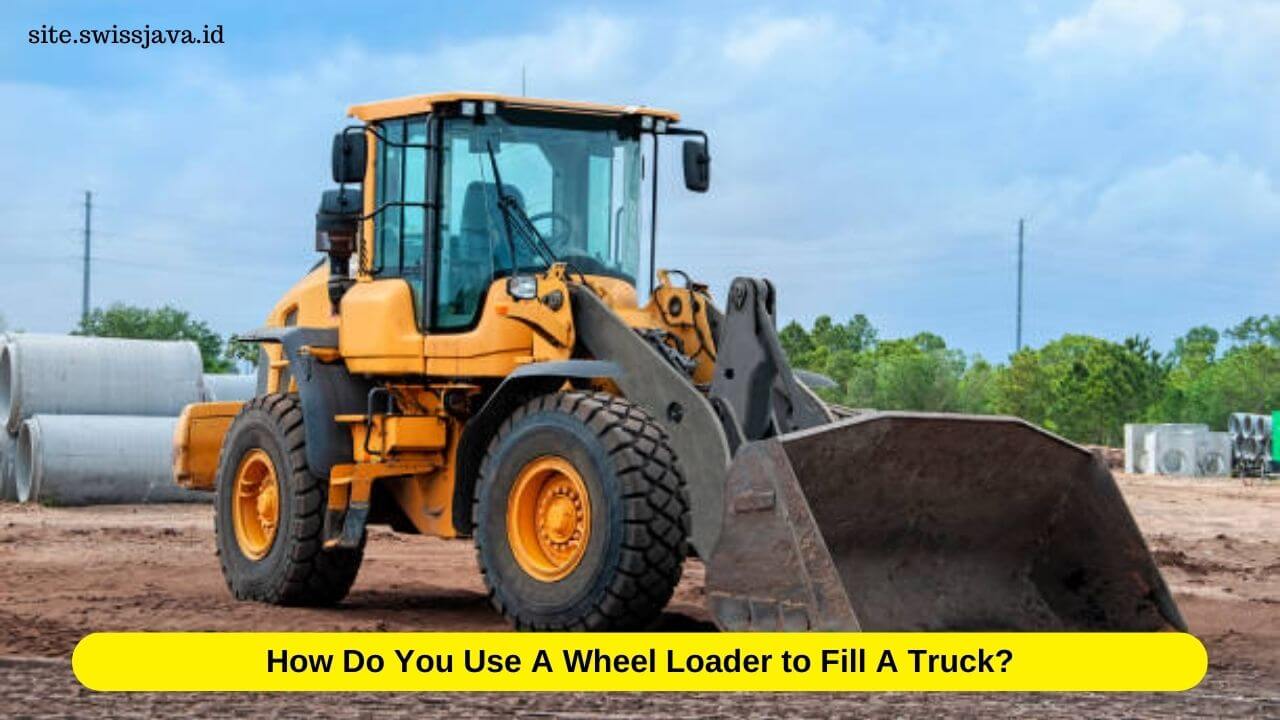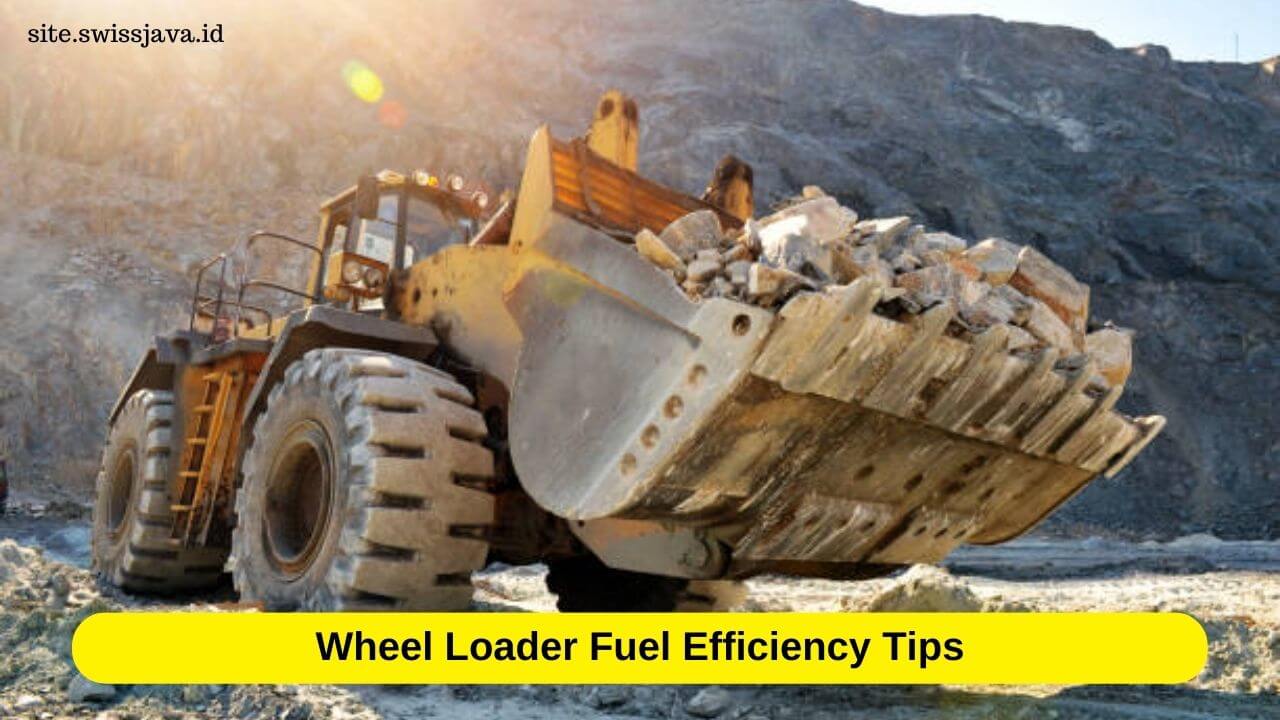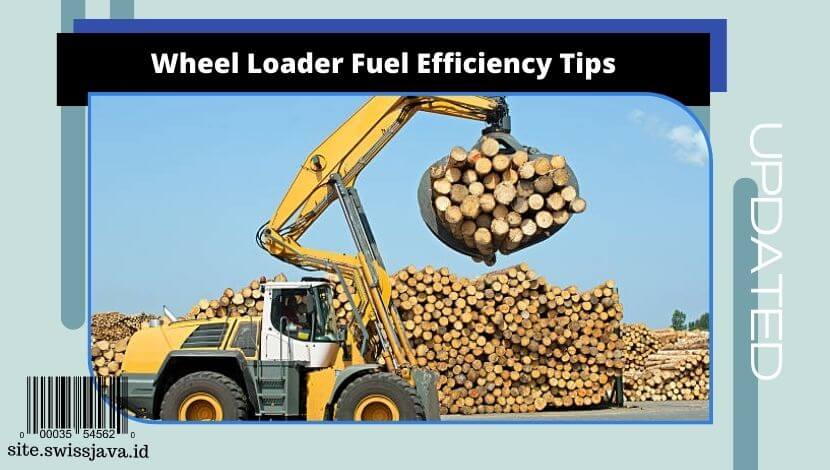Wheel Loader Fuel Efficiency Tips – A wheel loader is a versatile heavy equipment machine commonly used in construction, mining, and material handling tasks due to its ability to load, transport, and unload a wide variety of materials.
The front-mounted bucket of the wheel loader can be raised, lowered, and tilted using hydraulic controls, enabling efficient loading and unloading operations.
Wheel loaders come in various sizes, from compact models suitable for small worksites to large, high-capacity machines used in major construction and mining projects.
The operator sits in a comfortable and enclosed cabin with excellent visibility, controlling the wheel loader’s movements and attachments for safe and precise operations.
With their robust design, power, and mobility, wheel loaders are indispensable machines that contribute significantly to improving productivity and efficiency in diverse industries.
How Do You Use A Wheel Loader to Fill A Truck?

Using a wheel loader to fill a truck involves several steps to ensure safe and efficient loading. Here’s a general guide:
1. Position the Truck
Park the truck in a suitable location, ensuring it is on stable ground and the brakes are engaged.
Position the truck in a way that allows easy access for the wheel loader to load the material.
2. Approach the Truck
Drive the wheel loader slowly and carefully towards the truck, ensuring there is enough clearance for the loader bucket to reach the truck bed.
3. Set Up the Loader
Lower the loader bucket to the ground and tilt it slightly forward to prepare for loading. Ensure that the loader is stable and on level ground before proceeding.
4. Load the Material
Scoop up the material (such as dirt, gravel, or other loose materials) using the loader bucket.
Approach the truck bed and carefully lift the bucket to the desired height to avoid spillage or damage to the truck.
5. Load the Truck Bed
Position the loader bucket over the truck bed and slowly release the material, allowing it to flow evenly into the truck.
Be cautious not to overload the truck, as this can affect its stability and safety during transportation.
6. Level the Load
Use the loader bucket to evenly distribute the material inside the truck bed.
Ensure that the load is level and well-distributed to prevent shifting during transportation.
7. Repeat the Process
Continue the loading process until the desired amount of material is loaded into the truck.
Take breaks as needed to avoid overexertion and fatigue.
8. Perform Final Checks
Before leaving the loading area, inspect the truck bed to ensure no excess material is hanging over the sides.
Double-check that the load is secure and properly positioned.
9. Lower the Bucket and Park the Loader
After finishing the loading process, lower the loader bucket to the ground and park the wheel loader in a safe location.
10. Secure the Load
After the truck is fully loaded, secure the load using appropriate tie-downs and follow any local regulations regarding load securing.
Read More: 10+ Motor Grader Road Construction Techniques & Tips Buying It
What Is the Relationship Between Idle Time Reduction and Fuel Efficiency?

The relationship between idle time reduction and fuel efficiency is direct and significant.
Reducing idle time is one of the most effective ways to improve fuel efficiency in various types of vehicles and equipment, including cars, trucks, and construction machinery like wheel loaders.
When an engine is idling, it continues to burn fuel to maintain the engine’s running condition without actually performing any productive work.
This means that fuel is being consumed without contributing to the vehicle’s movement or the equipment’s operation, resulting in wasted energy and increased fuel consumption.
By reducing idle time, the engine operates less and consumes less fuel during non-productive periods.
This directly translates to better fuel efficiency and reduced fuel costs. For example:
1. Vehicles
In passenger vehicles and trucks, reducing unnecessary idling, such as leaving the engine running while parked, waiting in traffic, or during prolonged stops, can significantly improve fuel efficiency.
2. Construction Equipment
In the case of construction equipment like wheel loaders, reducing idle time when the machine is not actively loading or moving material can lead to notable fuel savings over time.
Minimizing idle time can be achieved through various means, such as:
- Turning off the engine during extended stops or breaks.
- Implementing engine auto-shutdown features, which automatically turn off the engine after a specified period of inactivity.
- Training operators and drivers to be mindful of reducing unnecessary idling.
Overall, idle time reduction is an essential fuel-saving strategy that directly impacts fuel efficiency.
It not only reduces operational costs but also contributes to environmental conservation by lowering greenhouse gas emissions associated with fuel consumption.
Read More: 10+ Bulldozer Safety Checklist Manual & Its Advantages
Wheel Loader Fuel Efficiency Tips

Improving wheel loader fuel efficiency not only saves costs but also reduces the environmental impact.
Here are some fuel efficiency tips for wheel loaders:
1. Regular Maintenance
Keep the wheel loader well-maintained with scheduled service and inspections.
Properly tuned engines, clean filters, and well-lubricated components can significantly improve fuel efficiency.
2. Use the Right Attachments
Choose attachments that match the task at hand to avoid unnecessary fuel consumption.
Using oversized buckets or attachments can put extra strain on the engine and increase fuel usage.
3. Optimize Operator Training
Train operators to use the wheel loader efficiently, avoiding excessive idling and unnecessary acceleration.
Encouraging smooth operation and reducing aggressive maneuvers can lead to fuel savings.
4. Monitor Tire Pressure
Maintain proper tire pressure as underinflated tires can increase fuel consumption.
Regularly check and adjust tire pressure to the manufacturer’s recommended levels.
5. Reduce Idle Time
Minimize idling whenever possible, as prolonged idling consumes fuel without contributing to productivity.
Encourage operators to shut off the engine during extended breaks.
6. Plan Work Efficiently
Organize work schedules to reduce travel time and distance for the wheel loader.
Minimizing unnecessary movements and optimizing work routes can save fuel.
7. Opt for Eco Modes
Many modern wheel loaders come equipped with eco modes or power management systems.
Utilize these features to adjust engine power to match the load and task, promoting fuel efficiency.
8. Weight Management
Avoid overloading the wheel loader, as carrying excessive weight requires more fuel to move.
Distribute loads evenly and avoid carrying empty buckets when unnecessary.
9. Monitor Fuel Consumption
Track fuel usage and implement a monitoring system to identify any sudden increases in consumption.
This helps detect potential issues or inefficiencies that may need attention.
10. Consider Hybrid or Electric Options
If feasible, explore hybrid or electric wheel loader options, as they can significantly reduce fuel consumption and emissions in certain applications.
Read More: 8+ Skid Steer Loader Attachment Guide And Its Benefits
Conclusion
A wheel loader is a heavy construction machine equipped with a large front-mounted bucket on a hydraulic lift arm, designed for various material handling tasks, such as loading and moving earth, gravel, sand, and other loose materials.
Wheel loaders are commonly used in construction, mining, agriculture, and landscaping industries due to their versatility, power, and maneuverability in navigating through rough terrains and confined spaces.
The operator sits in a protective cabin, using joystick controls to raise, lower, and tilt the bucket for efficient loading and unloading operations.
Wheel loaders come in different sizes, from compact models suitable for urban construction to large, heavy-duty machines used in mining and major earth-moving projects.
With their ability to accommodate various attachments, such as forks, grapples, and snowplows, wheel loaders are valuable tools in a wide range of applications, making them an essential part of modern construction and material handling operations.
